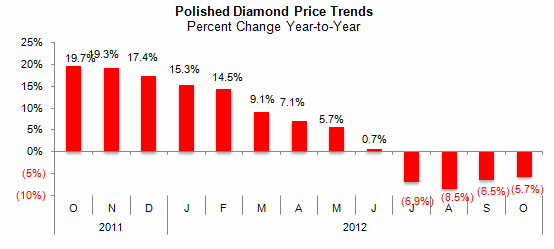IDEX Online Research: Polished Diamond Prices Drift Lower in October
November 06, 12
(IDEX Online) – Lackluster purchases by jewelry makers coupled with lots of uncertainty about the future have been unable to kick-start diamond demand. As a result, polished diamond prices continued to drift lower during October, according to the IDEX Online Polished Diamond Price Index.
Consumer demand for diamonds in the world’s largest retail jewelry market – the United States – remains muted, with retail merchants reporting low single digit sales gains.
Further, demand for jewelry – especially diamond jewelry – has softened in many other global markets. Uncertainty among shoppers appears to be at an all-time high: the U.S. election outcome could affect America’s relations with its allies, saber-rattling in the Middle East continues to wax and wane, meteoric growth of Asian economies has cooled, and the global economy continues to wobble, with daily dose of good – and bad – news.
While other commodities such as precious metals have begun to rise in price – even the U.S. housing market has begun to show signs of life, after several years of sharp declines – diamonds, with their closed markets and lack of trading transparency, have not shown an increase in value.
Polished Diamond Prices Drift in October
Polished diamond prices drifted slightly lower in October, slipping from a plateau established earlier this year, as the graph below illustrates:
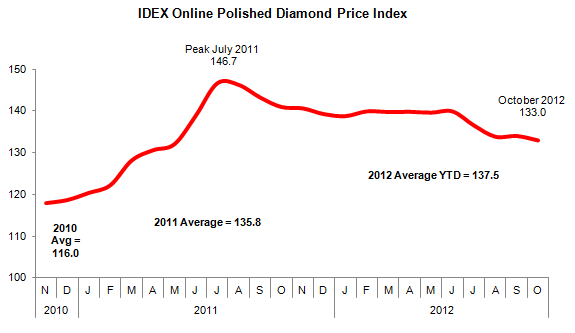 Source: IDEX Online |
The global polished diamond industry continues to seek some glimmer of good news that will push prices higher in the coming months. But, so far, there has been no definitive improvement in demand from either the mature markets such as the U.S. and Europe, or from emerging markets such as China.
Polished Diamond Price Trends
The IDEX Online Polished Diamond Price Index, widely acknowledged as the most transparent and accurate indication of prices in the polished diamond market, averaged 133.0 during the month of October. In September, the Index averaged 134.0; it stood at 141.0 a year ago.
Here’s what this means:
· October versus September prices: down 0.8 percent – Polished diamond prices in October were down 0.8 percent when compared to September. Month-to-month diamond prices have slipped six of ten months so far in 2012, a worrisome trend. The graph below illustrates monthly price changes for the global polished diamond market.
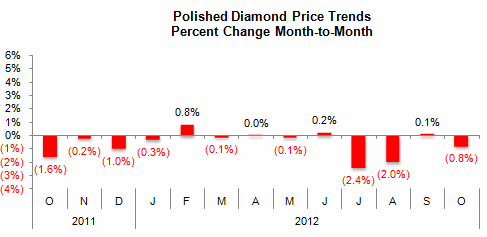 Source: IDEX Online |
· End-of-month prices versus beginning of month prices in October: down 1.0 percent – Polished diamond prices closed the month notably lower than at the beginning. This confirms the validity of the average price trends for the month. This trend has continued into November.
· October 2012 versus October 2011 prices: down 5.7 percent – The rate of decline in diamond prices on a year-to-year comparison has finally begun to decelerate very modestly, as the graph below illustrates.
|
Source: IDEX Online |
· Daily prices of polished diamonds were generally stable, though on a slight downward slope, throughout the month of October. The graph below illustrates daily price movements for polished diamonds during October 2012
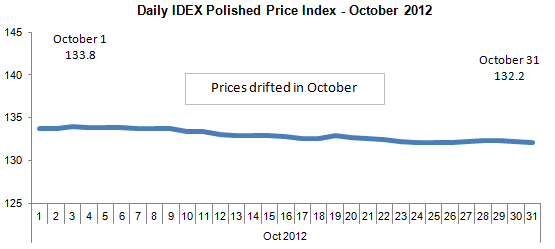 Source: IDEX Online |
· Year-to-date polished diamond prices are down 4.2 percent: For the first ten months of 2012, polished diamond prices have fallen by 4.2 percent from their January levels. This decline has continued to increase throughout the year.
· First ten months of 2012 average prices versus the same ten-month period in 2011: up 1.9 percent – Due to very weak prices in early 2011, the mathematical comparison of 2012 versus 2011 looks favorable. However, do not be deceived: 2012 diamond prices remain soft. The gap between 2012 average prices and 2011 average prices continues to close.
Diamond Prices by Size: Mixed, Though Generally Lower
Diamond prices by size declined for virtually all major sizes of round goods in October, when compared to prices in September. The good news: prices for half-carat and three-carat diamonds remained relatively flat. The graph below summarizes month-to-month price changes for polished diamonds by size.
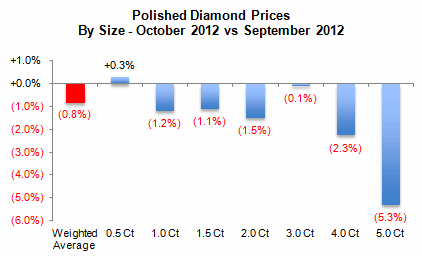 Source: IDEX Online |
On a year-over-year comparison, polished diamond prices in October were down for all key round diamond sizes, when compared to October 2011, as the graph below illustrates. These price declines were fairly consistent across all sizes of diamonds.
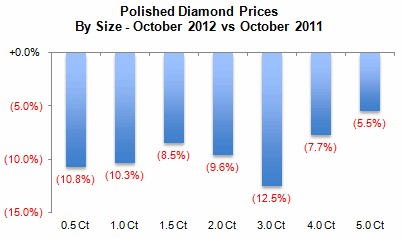 Source: IDEX Online |
Long Term Trend Shows Diamond Prices Weakening Since Mid-2011 Bubble
After rising slowly since mid-2010, most polished diamond prices – by carat size – were relatively stable during the first half of 2012, and then began to fall in the summer. Prices in September appeared to stabilize, but have slipped further in October. October polished diamond prices slipped for all major round stones, though they were up for almost all fancy cut stones. The graph below illustrates price trends by size for round diamonds.
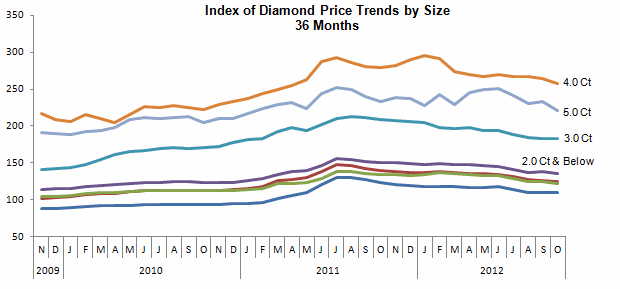 Source: IDEX Online |
Diamond Values Lag
When the value of diamonds over the past three years is compared to a similar value – or investment – in precious metals and U.S. stocks (the S&P 500), diamonds have not fared particularly well. Here are the conclusions:
· Diamond prices have not shown nearly as much volatility as prices of either precious metals or equities (U.S. stocks). That’s because the market is closed to speculators and outsiders who do not understand the industry.
· Diamond values – as measured by polished diamond prices – have under-performed the broad U.S. stock market as well as all precious metals except platinum.
The graph below illustrates diamond prices (red line) versus other similar investments in precious metals and stocks. This is a three-year performance evaluation, indexed at 100 in January 2010.
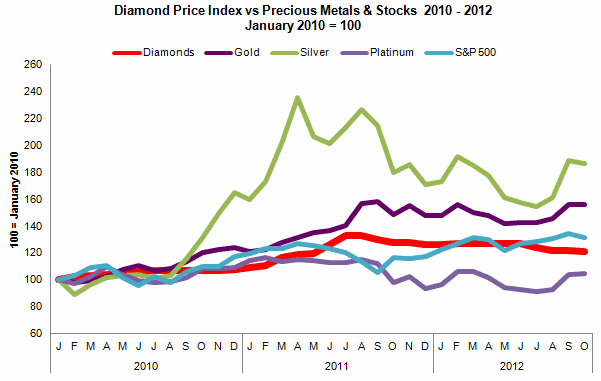 Source: IDEX Online |
During the three-year period shown on the graph, overall polished diamond prices have risen by 21 percent, while gold is up 56 percent, silver is up 87 percent, platinum is up by 5 percent, and U.S. stocks are up by 32 percent.
Short Term Outlook Unchanged – Lackluster Price Trends
With the global economy barely limping along, consumers in most parts of the world have tightened their purse strings and reined in their discretionary spending. All of the major publicly held international jewelry retailers and suppliers – Tiffany, Blue Nile, and Movado – have noted some weakening trends, even in some Asian markets. Overall, it appears that the current positive factors affecting diamond prices in 2012 are being cancelled by the negative factors.
· The OECD Composite Leading Economic Indicators for the Euro Area, continue to point to below-trend economic growth.
§ Europe is slowly slipping into a recession, and consumers have already cut spending. European diamond demand represents just under 15 percent of total global diamond and diamond jewelry sales.
§ U.S. economic growth remains lackluster, with very weak gains in the first half of 2012. Economic growth revisions have been show that economic activity in America was far less robust than earlier preliminary figures showed. Further, jewelry demand – as measured by fine jewelry sales at specialty retailers and other merchants – slowed in the first half of 2012 to a mid-single digit level from a string of double-digit quarterly gains in 2011. Diamond demand in the U.S. market represents nearly 40 percent of the global diamond market.
§ China’s diamond demand remains relatively solid, but its blazing economic growth during 2010 and 2011 has slowed this year. As a result, we expect diamond jewelry demand to pause from its previously torrid pace until it is clear that strong economic growth is sustainable in the country. China represents just over 10 percent of global diamond demand.
§ India’s demand for diamonds seems to be in a holding pattern currently, though the long-term prospects are very bright. India’s diamond demand represents about 12 percent of global demand.
§ Japan’s diamond demand is showing some recovery, but since this market is only 8 percent of global demand, it is not having a notable impact on diamond prices.
Longer Term Outlook Brighter For Diamond Demand
Longer term, polished diamond prices appear to be headed higher due to several factors within the diamond market:
· Emerging markets, including China and India, are poised for solid long-term growth. As consumer wealth builds in these markets, shoppers will be spending more on jewelry.
· Rough diamond supplies – based on credible data – appear to be flat, at best, for the next decade or longer. With flattish supply, but rising demand, the forces of capitalism will push diamond prices higher.
Until global economic conditions solidify and accelerate, it is unlikely that polished diamond prices will begin to move substantially higher near term.
The table below summarizes the average price of polished diamonds, using the IDEX Online Polished Diamond Price Index. The pre-recession peak for diamond prices occurred in August 2008 (box). As expected, polished diamond prices were weak during the “Great Recession” which officially ended in mid-2009. Unfortunately, polished diamond prices lagged the general economic recovery, and did not begin to show an upward bias until early 2010. The new, latest record price level (red box) occurred in July 2011. After slipping, prices remained relatively stable since October 2011, until July when they began slipping.
 |
